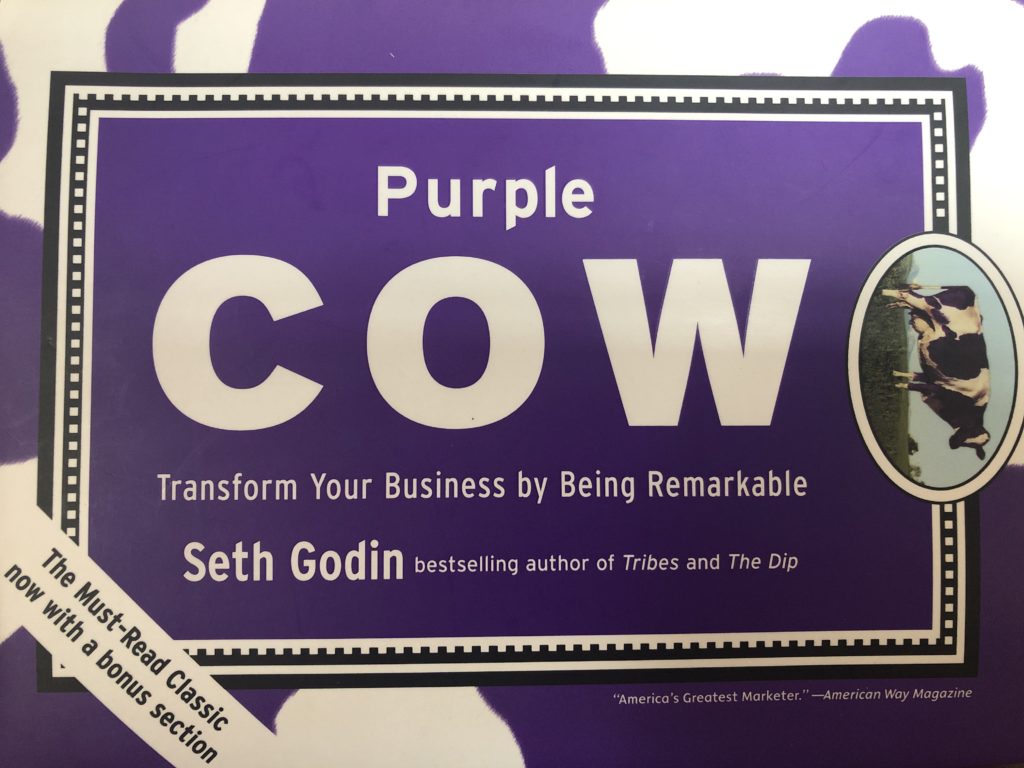The future is… Purple Cows
Posted by: Emma Sluiter
My Rating: 4/5 stars
Marketing guru Seth Godin’s Purple Cow is written for marketing professionals, and anyone who wants to expand their horizons with a unique perspective. He explores marketing strategies and uses case studies to help explain his point of view.
Godin begins by explaining that marketing doesn’t have enough “P’s,” referring to the famous “Four P’s of Marketing”:
- price,
- product,
- place,
- and promotion.
Godin suggests that we need to account for more “P’s,” such as positioning, publicity, pass-along, permission, and Purple Cows.
What are Purple Cows?
Purple Cows are standout experiences (like literally seeing a “Purple Cow”) that create more than just the typical desired outcome such as a purchase, a reaction, a click, etc. Purple Cows are a promotion technique that works best when the goal is to spread more than just awareness. The goal of a Purple Cow is to generate something deeper and more lasting: loyalty, a relationship, a creative spark, even an obsession.
Purple Cows are important in your business because people are too busy and will ignore your messages if you don’t break through the noise with something exceptional.
I know firsthand that consumers are frustrated with the clutter of advertisements and traditional marketing, so much that their disdain for ads has led them to ad blockers.
So, what should marketers do? Create Purple Cow experiences for consumers with otaku.
Otaku
Otaku is a Japanese term for people with obsessive interests. According to Godin, otaku describes something that’s more than a hobby, but a little less than an obsession.
Godin says, “Otaku is the overwhelming desire that gets someone to drive across town to try a new ramen-noodle shop that got a great review.”
As a marketer, I believe that otaku is an essential quality we are looking for in consumers. The more consumers have otaku towards your product, the more chances a Purple Cow phenomenon will occur.
A prime example of otaku in the United States is hot sauce. Boatloads of people are lining up to taste the hottest hot sauce and will compete in the most outrageous challenges. This obsession has led to a real business, therefore showing the impact of otaku.
Moving forward, we as marketers need to understand otaku-driven consumers to implement more successful products.
Final Thoughts
Purple Cow is a great book to gain inspiration for marketing professionals. Godin provides case studies that provide ideas on how to create remarkable experiences for our consumers.
My favorite case study was “How Dutch Boy Stirred Up the Paint Business.” Dutch Boy, a paint manufacturing company, created an entirely new product based on a key insight: people hated paint cans because they were heavy, hard to carry, hard to close, hard to pour from, and no fun. So, the marketing team changed the product, creating an easier to carry, easier to pour from, easier to close paint jug.
We need to take a design thinking approach towards marketing, and understand that sometimes you need to stop selling the product and think instead about how the consumers are engaging with it. If you exercise a little empathy, you can gain consumer insights that will increase purchasing decisions and sales.
That leads me to end with a question. How can you redefine what you sell and make it better?